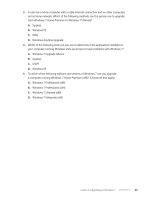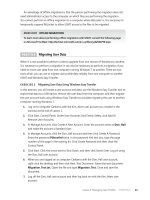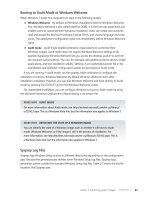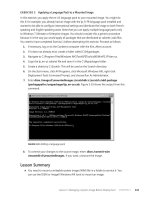Configuring Windows 7 (Training Kit) - Part 88 docx
Bạn đang xem bản rút gọn của tài liệu. Xem và tải ngay bản đầy đủ của tài liệu tại đây (130.93 KB, 10 trang )
843
Glossary
A
AppLocker policy A type of policy that can be used on
Windows 7 Enterprise and Ultimate editions to restrict
the execution of applications based on application
identity information.
B
boot image An image that boots a target computer
and enables deployment of the install image. Capture
and discover images are special types of boot image.
BranchCache A technology that allows files hosted on
remote Windows Server 2008 R2 servers to be cached
on a branch office LAN.
C
commit In the context of system images, you commit
a mounted image when you save the changes you
made to it back to the source image.
compatibility fix Also known as shims, compatibility
fixes are collected together to create compatibility
modes.
compatibility mode A collection of compatibility fixes,
also known as shims, that allow programs written for
older versions of Windows to run on Windows 7.
connection security rule A rule that determines
connection authentication requirements.
D
Data Collector Set (DCS) A DCS is a group of
performance counters that you can monitor over a period
of time so you can gauge a computer’s performance and
compare it to values stored in the same set of counters
recorded at an earlier time (known as a baseline).
Data Recovery Agent (DRA) A data recovery agent
is a user account and its associated enrolled certificate
that is used for the purposes of data recovery.
default gateway The IP address to which a host on
a subnet sends a packet (or IP packet) when the packet’s
destination IP address is not on the local subnet.
The default gateway address is usually an interface
belonging to the border router of LAN. In the case of
a SOHO or small test network, the default gateway is
the static IP address of the WAP or the ICS computer.
defragmentation Files on a hard disk can become
fragmented so that they are stored on noncontiguous
areas of the disk. Defragmentation addresses this
problem by rearranging the disk so files are stored in
contiguous areas.
deploy In the context of system images, you deploy
an image when you install it on one or more target
computers.
DirectAccess Technology that allows clients running
Windows 7 to establish an always-on remote IPv6
connection to an organization’s internal network.
distribution share A shared network folder that
contains a system image to be deployed an all the
files, such as unattend answer files, that are part of that
deployment.
driver store A protected area on disk that contains the
drivers for PnP devices.
844
Glossary
InPrivate Browsing A special mode of Internet
Explorer where browsing history, cookies and cache
data is not available after the browsing session ends.
InPrivate Filtering A filtering mode that is used to
reduce the amount of data sent to third party providers
when browsing the Internet.
install image The system image (typically a WIM file)
that you deploy to target computers.
IP address (IPv4 or IPv6) A unique address on
a computer network that devices use in order to
identify and communicate with each other.
IP packet The fundamental unit of information passed
across any IP network. An IP packet contains source
and destination addresses along with data and a
number of fields that define such things as the length of
the packet, the header checksum, and flags that indicate
whether the packet can be (or has been) fragmented.
L
library A virtualized collection of folders that often
contains similar content.
M
mount In the context of system images you mount an
image by expanding it into a folder so you can obtain
information about it and add or remove features such
as drivers, updates, and language packs.
multifactor authentication Two or more different
forms of authentication. On Windows 7, this is usually
achieved by requiring a smart card and a password.
N
Netbook A small form factor laptop computer. Also
known as a netbook computer.
O
Offline Files Allows files on specially configured
shared folders to be accessed when the computer is not
connected to the network.
outbound rule A firewall rule that applies to traffic
from the host addressed to an external location.
dual-boot An action where a computer can start up
a different operating system depending on which is
selected at boot.
dummy restore This occurs when files and folders
are restored to a location other than that in which they
were originally stored. You can use dummy restores to
check the restore process and to ensure that backed up
files and folders are not corrupt.
E
Encrypting File System (EFS) A technology that
allows the encryption of individual files and folders to
specific user accounts.
event forwarding Event forwarding enables you
to transfer events that match specific criteria to an
administrative (or collector) computer.
event log An event log stores events that occurred
during the operation of the computer system, such
as a service or application stopping or starting. Some
events store information about normal operations,
but others store error indications, such as when an
application failed to start a required service. Some events
are used to audit access to files and folders, for example.
event subscription An event subscription is
a configuration that permits events to be transferred
from a source to a collector computer. Subscriptions
can be source-initiated or collector-initiated.
G
global address An IPv6 address that identifies a device
on the Internet. Global addresses must be unique on
the Internet.
H
hash rule A rule that uses a digital fingerprint based
on a file’s binary properties.
HomeGroup A feature that allows resource sharing on
home networks.
I
inbound rule A firewall rule that applies to traffic
directed at the host from an external source.
845
Glossary
to continue using the computer. This works as a security
measure to ensure that users are not tricked into
providing UAC consent when they do not intend to do so.
shadow copy A shadow copy is a previous version of
a file or folder created at the same time as a restore
point.
side-by-side migration A process where user data is
exported from the original computer to the updated
computer.
Software Restriction Policy A type of policy that
can be used on all versions of Windows to restrict the
execution of applications based on application identity
information.
solution accelerator A group of downloads that,
in addition to installation files for a major software
package, also provides automated tools (if appropriate)
and additional guidance files.
staging An administrator can stage a device driver by
placing it in the driver store. A non-administrator can
then install the device.
subnet An identifiably separate part of an
organization’s network. Typically, a subnet might
represent all the computers at one geographic location,
in one building, or on the same LAN. An IPv4 address
consists of the address of a subnet (subnet address)
combined with the address of a device on the subnet
(host address).
subnet mask A number that defines what bits in an
IPv4 address represent the subnet address and what
bits represent the host address.
system image A disk image file that includes an
operating system.
System Image This is a copy of all the files and folders
on the system disk (and other specified hard disks) on
a computer. You can use a System Image backup to
restore the computer to exactly what its configuration
was when the System Image backup was created.
system restore A system restore restores a computer
system to a selected restore point. System restores do
not alter user files.
P
path rule A rule that specifies an application or group
of applications by their file location.
performance counter A performance counter
indicates the usage of a particular resource, for example
the percentage of time a processor is being used or the
amount of free RAM that is available.
preferred wireless network A wireless network
to which a wireless client attempts to connect and
authenticate. Typically, the list of preferred networks
contains networks to which the client has previously
connected listed in order of preference.
privilege elevation An increase in rights that allows
a user to perform a task that require more rights than
those assigned to a standard user.
public address An IPv4 address that identifies a
device on the Internet (or is allocated to a LAN). Public
addresses must be unique on the Internet.
publisher rule A rule that specifies a file or a group of
files based on the digital signature the vendor used to
sign the file.
R
Redundant Array of Independent Disks
(RAID) Volumes that use disk space on several disks to
implement volumes that offer increased performance,
fault tolerance, or both. Windows 7 supports RAID-0,
RAID-1, and RAID-5.
RemoteApp A form of presentation virtualization,
where the window of an application that runs on
a server is displayed on a client.
restore point A restore point contains information
about registry settings and other system information.
Windows 7 generates restore points automatically
before implementing significant system changes.
You can manually create restore points and restore
a computer system to a selected restore point.
S
Secure Desktop A special desktop where a user is
forced to respond to a UAC prompt before being able
846
Glossary
W
Windows Automated Installation Toolkit
(Windows AIK) A collection of tools and
documentation designed to help you deploy Windows
operating system images to target computers or to
a VHD.
Windows Preinstallation Environment
(Windows PE) A lightweight version of an operating
system (such as Windows 7) that is primarily used for
the deployment of client computers.
Windows Remote Shell A tool that allows
command-line commands to be executed on a remote
computer.
wipe-and-load migration A process where user
data is exported and the existing operating system is
removed and then replaced with the new operating
system. User data is imported.
T
transparent caching The process where files retrieved
from remote file servers that exceed a round-trip
threshold are cached automatically on the client to
speed up access.
Trusted Publisher store A protected area of a
hard disk that contains the digital certificates that
authenticate signed device drivers.
V
Virtual Hard Disk (VHD) A file with a .vhd extension
that acts as if it was a separate hard disk. In previous
operating systems, VHDs containing system images
were limited to virtualization and the facility was used
with Hyper-V, Virtual Server, and Virtual PC software
when implementing virtual machines. In Windows 7,
you can create and use VHDs on hardware PCs that are
not virtual machines.
847
IndexIndex
Symbols
and Numbers
.bat files, 279
.cmd files, 279
.com files, 274, 278
.js files, 279
.ocx files, 279–80
.ps1 files, 279
.swm files, 95
.vbs files, 274, 279
.xml migration files, 40
.zip files, 735, 738–39
16-bit components,
installation, 263
32-bit platforms
images, cross-architecture
tools, 71
servicing images, 75
64-bit platforms
images, cross-architecture
tools, 71
servicing images, 75
6to4, 335, 337, 516, 519
6to4 Relay Name, 518
A
Accelerators, 631
access control lists (ACL), 39
Account Is Locked Out, 501
Account Lockout Duration, 499
account lockout policies,
499–501
Account Lockout Threshold, 500
ACL (access control lists), 39
ACT (Application Compatibility
Toolkit), 260–64
Action Center, 609–10, 661–64
Action package, 139
activation, resetting, 82
Active Directory Certificate Services,
454, 520, 533.
See also certificates
Active Directory Domain Services
(AD DS), 385, 454, 559
Active Directory Security Group
Discovery, 176
Active Directory System
Discovery, 176
Active Directory System Group
Discovery, 176
Active Directory User
Discovery, 176
Active Directory Users
and Computers, 103–04
ActiveX, 625
AD DS (Active Directory Domain
Services), 385, 454, 559
AD DS servers, 103
ad hoc networks, 350, 360, 371–73
Add Application Wizard, 127
Add Features Wizard,
DirectAccess, 522
Add Features Wizard, Windows
Server 2008, 468
Add Hardware Wizard, 206
Add Printer Wizard, 369
Add-Drivers, 124
Additional Data, 734
addresses
IPv4, configuring
addressing, 301–07
connecting to network, 307–11
overview, 300–01
practice, configuring, 321–24
troubleshooting, 311–21
IPv6, configuring
address structure, 328–32
advantages of IPv6, 333–34
connectivity, 338–43
IPv4 compatibility, 334–37
practice, configuring IPv6
connectivity, 343–45
network connections, Windows
Firewall, 385
Admin Approval mode, 480, 482–83
Admin Approval Mode for Built-In
Administrator Account,
482–83
administrative rights and privileges
backup, 737
case scenario, UAC and
passwords, 511
compatibility modes, 260, 265
User Account Control (UAC)
overview, 479–80
policies, 482–87
practice, configuring, 488–90
Secpol and Local Security Policy,
487–88
settings, 480–82
verification of, 205
Windows Installer rules, 278
administrator passwords, wireless
networks, 367
Administrators group, 496
Advanced Boot Options, 750–53
Advanced Encryption Standard
(AES), 358–60
Advanced Recovery Methods,
748–49
Advanced Sharing dialog box, 428
Advanced Sharing Settings, 312,
350, 423, 434
AES (Advanced Encryption Stan-
dard), 358–60
aggregation, route, 333
alerts, performance counters, 652
Allow Access To BitLocker-Protected
Removable Data Drives, 565
Allow Log On Through Remote
Desktop Services, 496
Allow UIAccess Applications To
Prompt For Elevation Without
Using Secure Desktop, 486–87
Analyze Disk, 230
848
answer file
authorization
account policies, 499–500
case scenario, UAC and
passwords, 511
certificates, managing, 502–04
Credential Manager, 493–95
practice, managing credentials,
504–07
resolving authentication issues,
500–01
Runas, 495–96
smart cards, 497–99
user rights, 496–97
Auto-Add policy, 99, 103–04
auto-connect, wireless
networks, 368
Automated.xml, 138
automatic backups, 736–39
Automatic Private Internet Protocol
(APIPA), 300, 305, 307
Automatic Updates, 613
Automatically Fix File System
Errors, 233
Automatically Generate Rules
wizard, 283
Autounattend.xml, 71
availability, 243–45
B
Background Intelligent Transfer
Service (BITS), 150
background services, 710
backup. See also Backup and
Restore console; recovery, data
case scenarios, 779–80
Credential Manager, 493–95
practice, configuring file and
folder backup, 741–43
scheduling, 731–39
System Image backups, 739–41
thick images, 150
Backup and Restore console
Restore My files, 763
scheduling backups, 731–39
System Image backups, 739–41
Volume Shadow Copy Service
(VSS), 766
Backup Operators group, 497
Backup Set folder, 738
BackupGlobalCatalog, 740
backward compatibility, 117, 497
bandwidth, USB host
controller, 203
auditing, 285–86
configuring exceptions, 283
practice, restricting applications,
286–89
rules, 277–83
Software Restriction Policies,
271–76
architecture, cross-architecture
tools, 71
auditing
AppLocker, 285–86
audit mode, booting to, 83
auditSystem, configuration pass,
80
auditUser, configuration pass,
80–81
remote connections, 544
Security event log, 673–80
shared resources, 449–51
authentication
account policies, 499–500
BitLocker requirements, 561
case scenario, UAC and
passwords, 511
certificates, managing, 502–04
Credential Manager, 493–95
DirectAccess, 516, 520–21
event forwarding, 676
HomeGroup Connections, 425
internal wireless adapters,
357–60
Network Security Key, 355
port-based, 358–60
practice, managing credentials,
504–07
Remote Desktop, 539
remote management, 409–10
removable data drives, 564
resolving issues, 500–01
Runas, 495–96
smart cards, 497–99
User Account Control (UAC)
overview, 479–80
policies, 482–87
practice, configuring, 488–90
Secpol and Local Security Policy,
487–88
settings, 480–82
user rights, 496–97
virtual private networks (VPNs),
531–33
Windows Firewall with Advanced
Security (WFAS), 393–94
wireless networks, 367
Authentication exemption
rules, 393
answer file
booting to audit file, 83
building, 59–64
creating, 139–40
package installation, 131
reference installation, building,
65–66
settings, saving, 64–65
Sysprep, 80–81
Unattended.xml, 127, 137–40
anti-spyware, 661–64
antivirus, 661–64
anycast, 329, 332
API (application programming
interface), compatibility, 262
APIPA (Automatic Private Internet
Protocol), 300, 305, 307
AppData, 734
Application Compatibility
Diagnostics policies, 264–65
Application Compatibility Toolkit
(ACT), 260–64
application control policies.
See AppLocker
Application Identity Service, 277
application programming interface
(API), compatibility, 262
application settings, 40
applications
event logs, 674
performance, 717
RemoteApp, 539–40
system restore, 747
applications, managing.
See also AppLocker
adding, MDT, 164–66
Application Compatibility
Diagnostics policies, 264–65
Application Compatibility Toolkit
(ACT), 260–64
case scenarios, 294–95
compatibility, configuring options,
257–60
inventories, 175–76
overview, 255
practice, compatibility, 267–69
practice, restricting applications,
286–89
servicing, 125–27
Software Restriction Policies,
271–76
WIM images, 120
Windows XP Mode, 265–66
AppLocker
application control policies,
overview, 276–77
849
Change Adapter Settings
offline files, 596–97
passwords, problem
resolution, 511
performance monitoring, 725–26
remote access, 550–51
remote management, 419
shared resources, 474
system and configuration issues,
779–80
system image, generating, 111
User Account Control (UAC), 511
VHDs, working with, 111
Windows Firewall, 419
wireless networks, 377–78
Catalogs folder, 739–40
CD-ROM
backups, 736
bootable Windows PE, 66–68
Removable Disk policies, 234–35
cell phones, 233–35, 540
cellular modems, 360
certificate authority (CA)
device drivers, 215–19
DirectAccess, 520
SSL certificates, configuring, 633
User Account Control (UAC),
485–87
Windows Firewall with Advanced
Security (WFAS), 393
wireless adapter security, 359–60
certificates
certificate of authenticity
(COA), 82
certificate rules, 272, 276
certificate store, device drivers,
215–19
Credential Manager, 493
data recovery agents (DRAs), 559
DirectAccess, 520–21
EFS and HomeGroups, 454
Encrypting File System (EFS), 452
errors, 635
Group Policy, 521
Internet Explorer, revocation
checks, 626
managing, 502–04
Recovery Agents, 453
smart cards, 497–99
SSL certificates, configuring,
633–36
VPN authentication protocols, 533
Certificates Console (Certmgr.msc),
502–04
Challenge Authentication Protocol
(CHAP), 533
Change Adapter Settings, 316
boot options, 754–55
boot time filtering, 384
Bootmgr.exe, 754–55
performance, 717
System Configuration (MSConfig),
705–07
target computers, manually,
173–74
Xbootmgr.exe, 718
BranchCache
configuring clients, 463–67
Distributed Cache Mode, 463
Hosted Cache mode, 462
overview, 461–62
practice, BranchCache configura-
tion, 470–71
vs transparent caching, 577
Windows Server 2008, 468–70
broadcast address, 303
broadcast traffic, 333
Browsing settings, 716
bus-powered hubs, 202
C
cabinet (.cab) files, 127–28
caching
BranchCache
configuring clients, 463–67
Distributed Cache mode, 463
Hosted Cache mode, 462
overview, 461–62
practice, BranchCache
configuration, 470–71
Windows Server 2008, 468–70
negative, 314–15
neighbor cache, 341
offline files, 574–82
Offline Settings, 430
shared folder options, 431
transparent caching, 577
write caching, configuring, 711–12
capture images, WDS, 74, 100, 172
case scenarios
application compatibility, 294
applications, restricting, 294–95
backup and restore, 779
deploying an image, 191–92
driver signing policy, 252
installing Windows 7, 49
Internet Explorer, 644–45
IPv4 connectivity, 377
IPv6 connectivity, 377
managing disk volumes, 252
basic disks, 241–42, 248
basic partitions, 235
battery power, 582–89
BCD (Boot Configuration Data),
754–55
BCDBoot, 71, 173
BCDEdit, 93–94, 148, 173, 754–55
Behavior of the Elevation Prompt
for Administrators in Admin
Approval Mode, 483
Behavior of the Elevation Prompt
for Standard Users, 485
binary notation, 302
Biometric authentication, 498
BIOS, Windows XP Mode, 265–66
BitLocker
BitLocker To Go, 564–67
data recovery agents (DRA),
559–61
enabling, 561–63
Encrypting File System (EFS) and,
451–52
modes, 556–57
offline migrations, 42–43
overview, 555–56
practice, BitLocker To Go, 568–71
TPM chip, 557
BITS (Background Intelligent
Transfer Service), 150
Block rules, 277–78
Blog accelerator, 631
Bluetooth, 356
Boot Configuration Data
(BCD), 148, 754–55
boot images
WDS, 74, 100–01, 170
Windows PE, 116
bootable media. See also booting
discover images, 171–72
dual-boot installations, 14–19
LTI bootable media, configuring,
168–69
operating system packages,
servicing, 127–30
practice, creating Windows PE
boot DVD, 84–86
task sequence, deploy to VHD,
159–61
VHD, 90, 93
WIM2VHD, 94–96
Windows boot options, 754–55
Windows PE, 66–68
booting. See also bootable media
audit mode or Windows
Welcome, 83
boot environment, 556, 566–67
850
Change Advanced Sharing Settings
Configuration Manager 2007, 163,
176–77, 179
configuration passes, Windows
Setup, 79–80
Configure Schedule, 230
Configure Use of Passwords For
Removable Data Drives, 565
Configure Use Of Smart Cards On
Removable Data Drives, 564
configuring. See also configuring,
system images
application compatibility, 257–60
BranchCache, configuring clients,
463–67
default operating systems,
dual-boot, 17–19
deployment points, 166–68
device installation policies, 207–08
DirectAccess, client configuration,
517–21
event subscriptions, 677–79
firewall exceptions, 387–88
HomeGroup settings, 435–38
Hosted Cache servers, 462
international settings, 131–33
Internet Explorer
add-ons and search providers,
630–32
case scenario, 644–45
Compatibility View, 622–23
InPrivate Mode, 627–30
pop-up blocker, 632–33
practice, InPrivate Mode
and add-ons, 636–40
security settings, 623–26
SmartScreen filter, 626–27
SSL certificates, configuring,
633–36
IPv4
addressing, 301–07
connecting to network, 307–11
overview, 300–01
practice, configuring network
connectivity, 321–24
troubleshooting connectivity,
311–21
IPv6
address structure, 328–32
advantages of IPv6, 333–34
connectivity, 338–43
IPv4 compatibility, 334–37
practice, configuring IPv6
connectivity, 343–45
LTI bootable media, 168–69
networking performance, 715–16
performance settings
Diskpart, VHDs, create and
attach, 91
Driver Verifier Monitor, 214–15
Icacls, 446–47
Ipconfig, 301
IPv6 connectivity, 338–43
More Info, 671
Net Share, 431
Netsh, 310–11, 352–56,
463–67, 608
Netstat, 319–21
PEimg.exe (Windows PE), 116
Ping, 312–15
power configuration, 587–89
Robocopy.exe, 449
Runas, 495–96
Secedit.exe, 487–88
Sysprep, 77–84
Unattend.xml answer files,
137–40
USMT (User State Migration Tool),
39–42
Wbadmin, 739
WDSUTIL, 99
WIM2VHD, 94–96
WinRS (Windows Remote Shell),
409–10
common criteria mode, 497
Common Information Model (CIM)
repository, 694–96
Common Information Model Object
Manager (CIMOM), 694–95
Compatibility Administrator, 261–62
compatibility fix, defined, 262
compatibility modes, defined, 262
compatibility, applications
Application Compatibility
Diagnostics policies, 264–65
Application Compatibility Toolkit
(ACT), 260–64
backwards compatibility, 117, 497
case scenarios, 294–95
configuring, 257–60
practice, Windows 7 compatibility,
267–69
Windows XP modes, 265–66
complete PC backup, 740
complete recovery, 749–50
compressed (.zip) files, 735, 738–39
compressed folders, 452
compressed migration stores, 42
compression, backup, 730
computer health check, 656–58
Cone NATs, 337. See also NAT
(Network Address Translation)
Config.xml, 40
Change Advanced Sharing
Settings, 350
CHAP (Challenge Authentication
Protocol), 533
Check For Updates, 601–02
Choose How BitLocker-Protected
Removable Drives Can Be
Recovered, 566
CIDR notation, 303
CIM (Common Information Model)
classes, 696
CIM (Common Information Model)
repository, 694–96
CIMOM (Common Information
Model Object Manager),
694–95
Cipher.exe, 453, 502–04
Class Explorer, 699
class store, 695–96
Class Viewer, 699
client computers. See also system
images, configuring
backups, VHDs, 89
discovery, 176
images, distributing, 72–75
installing, small numbers, 66
IP configurations, 308
IP settings, 314
network share, deploying,
69–71
operating system packages,
servicing, 127–30
pre-staging, 103–04
remote management
case scenarios, 419
practice, remote management
options, 411–15
Remote Assistance, 405–08
Remote Desktop, 402–04
Windows Remote Management,
408–10
Client for Microsoft Networks, 362
client-side rendering (CSR), 369
COA (certificate of authenticity), 82
colors, 259, 369
COM objects, policies, 265
Command Prompt, 752
command-line tools
BCDEdit, 93–94, 148, 173, 754–55
BitLocker, Manage-bde.exe, 567
Cipher.exe, 453, 502–04
Defrag, 231–32
Deployment Image Servicing and
Management Tool (DISM),
56–58, 75–77, 116–23, 125,
128, 137–40
851
creating
practice
configuring IPv6 connectivity,
343–45
creating ad hoc network, 371–73
wireless networks
managing, 356–57
security, 367–68
technologies, 361
troubleshooting, 363–67
consent, UAC, 484
Contacts, 734
Content Retrieval rule, 463
Control Use of BitLocker On
Removable Drives, 564
Convert To Dynamic Disk, 237
copying files, 448–49
Copype.cmd, 66–68
Core Networking Inbound Rules,
317–18
Core Networking Outbound Rules,
317–18
Create A Basic Task Wizard, 675
Create A Password Reset Disk, 500
Create A Shared Folder Wizard, 431
Create New Data Collector
Wizard, 655
creating
answer files, Windows SIM, 81,
139–40
bootable DVD-ROM, 58
bootable Windows PE medium,
66–68
capture image, 100, 172
Data Collector Sets, 654
data collectors from command
prompt, 655–56
discover images, WDS, 171–72
disk volumes, 241
distribution share, 139, 152–53
event subscriptions, 679–80
images, 75
mirrored volume (RAID-1), 243
power plan, custom, 586
practice
bootable VHD, 105–08
creating ad hoc network, 371–73
power plan, custom, 589–92
WIM image, 84–86
reference image, 58–72
scripts, network share
deployment, 70
simple volumes, 241
striped volume with parity
(RAID-5), 243–45
striped volumes (RAID-0), 242–43
VHD, native, 90–91
Windows Automated Installation
Kit (Windows AIK), 56–58
Windows Image to Virtual Hard
Disk Tool (WIM2VHD),
94–96
Windows Preinstallation
Environment (WinPE), 58
conflicts
device drivers, 209–14
offline files, 575, 578–80
Connect To A More Preferred
Network, 364
Connect to Network Folder,
task sequence, 178
connections. See also remote
management; Windows
Firewall
DirectAccess
client configuration, 517–21
overview, 515–17
practice, configuring with Netsh,
526–27
server, configuring, 521–26
troubleshooting, 519–21
remote
auditing, 544
case scenarios, 550–51
dialup connections, 540
incoming connections,
accepting, 541–43
NAP remediation, 536–37
practice, configuring remote
connections, 545–47
Remote Desktop, 537–40
virtual private networks (VPNs),
530–32
VPN Reconnect, 535–36
statistics about, 319–21
Windows Firewall with Advanced
Security (WFAS), 393–94
connectivity
ad hoc networks, 360
case scenario
IPv4 connectivity, 377
IPv6 connectivity, 377
wireless networks, 377–78
computer to computer, 312
internal wireless adapter security,
357–60
IPv6, configuring, 338–43
networks
managing connections, 362–63
overview, 348–50
setting up connections, 350–52
wireless computers, adding,
352–56
CIM Classes, 696
CIM Repository, 695–96
Performance Options, 709–11
WMI Administrative Tools,
697–705
WMI consumers, 696
WMI providers, 694–95
WMI scripting library, 696–97
WMI Service, 695
WMI, CIMOM, 695
WMI, overview, 689–94
permissions, Icacls, 446–47
practice
BitLocker To Go, 568–71
BranchCache, 470–71
downloading, installing and
configuring MDT 2010,
181–87
remote connections, 545–47
User Account Control (UAC),
488–90
Windows Firewall, 395–98
Windows Update, 617–19
processing, Task Manager, 714–15
Remote Desktop, 403–04
shared folders, 580–81
SSL certificates, 633–36
system protection, 756–60
system protection and disk usage,
configuring, 769–71
WDS, 169
Windows PE options, 168
Windows Update, 601–08
write caching, 711–12
configuring, system images
case scenario, generating system
images, 111
Deployment Image Servicing and
Management Tool (DISM),
75–77
distributing, 72–75
Offline Virtual Machine Servicing
Tool, 96–98
overview, 53
practice, creating bootable VHD,
105–08
practice, creating WIM image,
84–86
pre-staging client computers,
103–04
reference image, creating, 58–72
Sysprep, 77–84
VHDs, native, 89–94
WDS images, 74–75
WDS, online VHD deployment,
98–104
852
Credential Manager
system images, configuring
and modifying, 56–58
unattended servicing,
command-line, 137–40
WIM commands, mounting
an image, 116–23
Deployment Workbench, 73,
148–51, 164–66
Designated Files Types, 274
desktop, 259
backup, 734
migrating user profile data, 34
Remote Desktop, 402–04, 411–13,
496–98, 537–40
Secure Desktop, 480, 483–84,
486–87
Desktop Background Settings, 585
Detect Application Failures, 265
Detect Application Install Failures,
265
Detect Application Installations
and Prompt for Elevation, 485
Detect Applications Unable to
Launch Installers Under
UAC, 265
Device Installation Settings, 204
Device Manager, 197–203, 209
devices and drivers
Application Compatibility
Manager, 261
case scenario, signing policy, 252
configuring installation policies,
207–08
conflict resolution, 210–14
driver signing and digital
signatures, 215–19
Driver Verifier Monitor, 214–15
File Signature Verification,
218–19
installation, overview, 203–04
installing non-PnP devices, 206
installing, Windows Update,
204–06
Link-layer Topology Discovery
Mapper I/O driver, 362
out-of-box, 66
plug and play, persisting, 81
practice, configuring policy and
driver search, 220–25
printers, sharing, 434
staging, 205
System Diagnostics, 652
updates, 209
wireless, connections to WAP, 349
working with device drivers,
208–10
WDS, online VHD deployment,
98–104
Windows 7, More Info, 71
deploying, system images
applications, servicing, 125–27
case scenarios, 191–92
DISM WIM commands, 116–23
drivers, servicing, 123–25
images, distributing, 72–75
international settings, 131–33
manual installations, 180–81
Microsoft Deployment Toolkit
overview, 146–51
Microsoft Deployment Toolkit
(MDT)
applications, adding, 164–66
deployment points, 166–68
device drivers, adding, 154–55
distribution shares, creating,
152–53
language packs, 164
LTI bootable media, 168–69
managing and distributing
images, overview, 151–52
offline files, updating, 163–64
operating system image, adding,
153–54
program folders, 148
task sequences, 155–61
updates, adding, 161–63
Windows PE options,
configuring, 168
operating system packages,
servicing, 127–30
package installation, 131
practice
downloading, installing and
configuring MDT 2010, 181–87
mounting offline image and
installing language packs,
140–43
SCCM 2007, 175–80
unattended servicing,
command-line, 137–40
WDS, 169–75
Windows editions, managing,
133–35
Windows PE images, servicing,
135–36
Deployment Image Servicing and
Management Tool (DISM)
applications, servicing, 125
description, 57
operating system packages,
servicing, 128
overview, 75–77
WDS, discover image, 101
Windows Firewall with Advanced
Security (WFAS) rules, 389–91
Credential Manager, 493–95
credentials, 484, 495–96,
504–07, 737
cross-architecture tools, 71
Cryptographic Operators
group, 497
Cscript, 94
CSR (client-side rendering), 369
D
Data Collector Sets (DCS), 649,
652–58, 725
data confidentiality protocol, 531
Data Execution Prevention (DEP),
710–11
data integrity protocol, 531
data origin authentication
protocol, 531
data recovery agents (DRA), 559–61
data-collection packages, 261
DCOM (distributed component
object model), 704
DCS (Data Collector Sets), 649,
652–58, 725
DDNS (Dynamic Domain Name
Service), 305
debugging.
See also troubleshooting
boot configuration data, 754–55
network statistics, 319–21
operating system on VHD, 95
Debugging Mode, 751–52
default gateway, 304–05, 392
Default Local Users Group, 497
default rules, 272, 277
deferred procedure calls (DPC), 717
defragmenting disks, 230–32
deleting volumes, 246
deletion, files and folders, 442–43
Deny Write Access To Removable
Drives Not Protected By
BitLocker, 565
DEP (Date Execution Prevention),
710–11
deploying. See also deploying,
system images; Deployment
Image Servicing and
Management Tool (DISM)
network share, 69–71
updates, 161–63, 611









